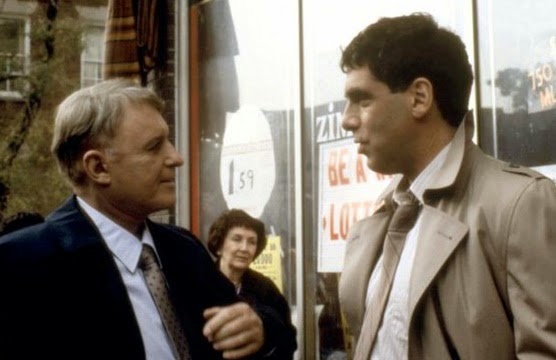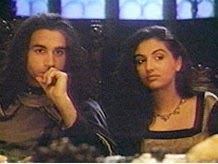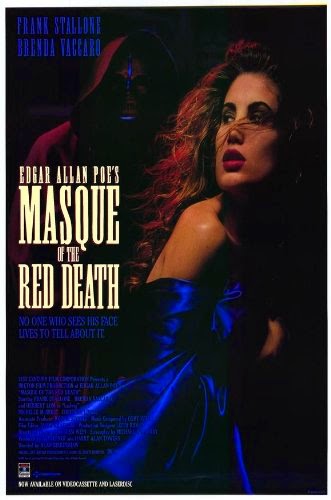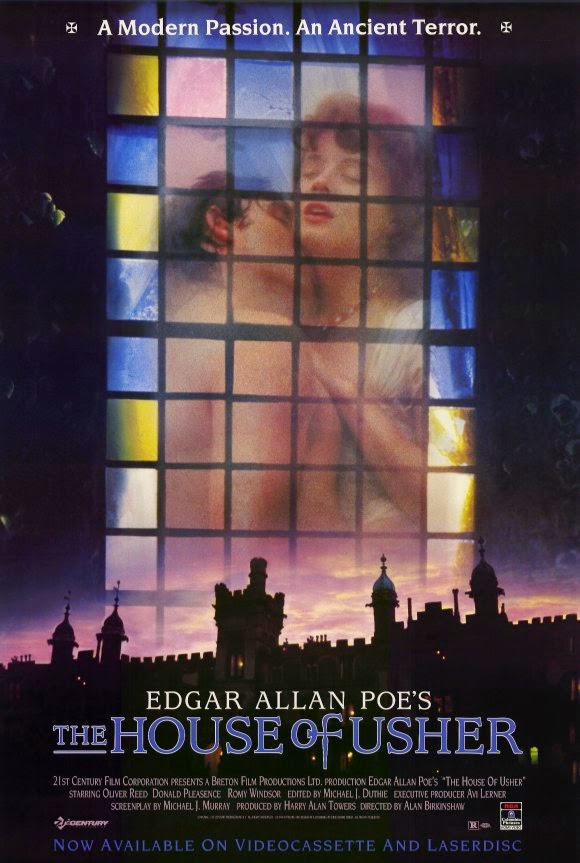DON'T OPEN TILL CHRISTMAS
(UK - 1984)
Directed by Edmund Purdom and Al McGoohan (Derek Ford, Alan Birkinshaw). Written by Derek Ford and Al McGoohan (Alan Birkinshaw). Cast: Edmund Purdom, Alan Lake, Belinda Mayne, Gerry Sundquist, Mark Jones, Caroline Munro, Kelly Baker, Pat Astley, Kevin Lloyd, Wendy Danvers, Lawrence Harrington. (Unrated, 86 mins)The November 9, 1984 release of
SILENT NIGHT, DEADLY NIGHT, with its concept of a homicidal, axe-wielding maniac dressed as Santa Claus, was the subject of a major controversy, a media circus, and a ludicrously hyperbolic condemnation from
Siskel & Ebert. It's not like the idea of Christmas-themed horror was new: we'd already seen Bob Clark's terrifying
BLACK CHRISTMAS (1974), the original "the calls are coming from inside the house!" scenario with a hidden killer stalking the stragglers at a sorority house during Christmas break, and the opening "And All Through the House" segment of Freddie Francis'
TALES FROM THE CRYPT (1972) and Lewis Jackson's
CHRISTMAS EVIL, aka YOU BETTER WATCH OUT (1980) both dealt with the idea of a killer Santa long before SILENT NIGHT, DEADLY NIGHT was nearly banned because of it. The breathless panic and the cries of "What about the children?!" that surrounded SILENT NIGHT, DEADLY NIGHT had more to do with the mindset of the time than anything inherently offensive in the film, which, for the record, is not very good, though even it has its one legitimately
iconic moment. Thanks to HALLOWEEN (1978) and FRIDAY THE 13TH (1980), and the flood of imitators that hitched a ride on the bandwagon, the popularity of slasher films was at an all-time high. Much like today's debate over the violence in video games, there was much parental concern about things like movie violence and the "Satanic Panic" of the era, with heavy metal acts like Ozzy Osbourne, W.A.S.P., and Judas Priest being the favorite targets of outraged parents. There was a growing belief that if kids were bad, it had to be the movies they were watching, the music they were hearing, and the books they were reading.
![]()
Prior to SILENT NIGHT, DEADLY NIGHT's release, protest groups announced plans to picket and demonstrate outside theaters showing the film. But, as in most cases like this, all they really succeeded in doing was drawing more attention to a cheap, forgettable film that, because of all the media hype, stayed in theaters for two weeks instead of just the one it would've lasted had the protesters simply said and done nothing at all. SILENT NIGHT, DEADLY NIGHT landed in eighth place at the box office in its opening weekend, dropped significantly in its second weekend, and was gone--or "pulled from release," depending on who's telling the story--by Thanksgiving, with a May 1985
re-release generating little fanfare. It's still revered as a "classic" by '80s horror fans prone to grading on an overly nostalgic curve, and it spawned four sequels (the last two in-name-only) and an abysmal 2012
remake. But late 1984 also saw
another Santa-themed slasher film that fell through the cracks: the British-made DON'T OPEN TILL CHRISTMAS only got a very limited release on December 7, 1984 by exploitation outfit 21st Century Distribution Corp. before turning up in video stores several months later courtesy of the immortal
Vestron Video. DON'T OPEN TILL CHRISTMAS was produced by veteran American schlockmeister Dick Randall, who had just set up shop in London after a decade-long run in Italy and Hong Kong, and Steve Minasian. Minasian was a veteran in grindhouse distribution and theatrical exhibition, a co-owner of Esquire Theaters and Hallmark Film Distributors. Minasian helped conceive the infamous
"vomit bag" campaign for Hallmark's 1970 release of the German WITCHFINDER GENERAL ripoff MARK OF THE DEVIL. He was Randall's business partner on a number of 1980s European ventures, including the Spanish PIECES (1983) and the British
SLAUGHTER HIGH (1986), but is perhaps best known for being involved as an investor in Georgetown Productions, the company that independently-produced FRIDAY THE 13TH. Minasian knew producer/director Sean S. Cunningham, who produced the Hallmark-released Wes Craven debut THE LAST HOUSE ON THE LEFT (1972). Minasian was a money man, had no creative input in FRIDAY THE 13TH or the first four sequels that carried a Georgetown Productions credit, and he isn't individually credited anywhere on the film, but that didn't stop him or Randall from exploiting that connection to the box-office phenomenon time and again throughout their partnership.
![]() |
| Purdom in a 1954 MGM publicity shot |
Perhaps the most interesting figure involved in DON'T OPEN TILL CHRISTMAS was Edmund Purdom. Purdom (1924-2009) was a British actor who had some small roles in a few UK films and appeared on Broadway with Laurence Olivier and Vivien Leigh before heading to Hollywood in search of stardom. He had bit parts in TITANIC (1953) and JULIUS CAESAR (1953), and in 1954, lucked into the lead in the lavish MGM musical THE STUDENT PRINCE. Mario Lanza quit the film over a dispute with the studio, who apparently expressed their displeasure with the star's sudden weight gain. The very popular Lanza, a beloved tenor who parlayed his voice into a movie career, was prone to binge-eating and wildly fluctuating weight. He had already recorded the soundtrack to THE STUDENT PRINCE before shooting began on the film, and as a result, MGM owned the rights to the music. This put Purdom in the awkward position of
lip-syncing Lanza's vocals in a film that was actually advertised as "featuring the singing voice of Mario Lanza!" The film was a huge success, but people were going to hear Mario Lanza, not to see Edmund Purdom. Purdom's next film was the 20th Century Fox mega-budget Biblical epic
THE EGYPTIAN. Marlon Brando was cast in the lead, but decided he didn't like the script and bailed at the eleventh hour. Fox courted Farley Granger and an up-and-coming Dirk Bogarde, and both declined the offer. Scrambling, they finally settled for their fourth choice--Purdom--and, coming on the heels of the Lanza brouhaha over THE STUDENT PRINCE, the Hollywood gossip rags started derisively referring to him as "The Replacement Star." MGM offered him a contract and appeared committed to making Edmund Purdom happen: he and Vic Damone romanced Jane Powell and Debbie Reynolds in the musical
ATHENA (1954), with Purdom's character being the only lead to get no musical numbers, presumably because MGM had no more Mario Lanza vocal tracks lying around; he starred with Lana Turner in the epic spectacle
THE PRODIGAL (1955); and was billed above the likes of David Niven and George Sanders in the swashbuckler
THE KING'S THIEF (1955). None of these three post-EGYPTIAN films were successes, and just like that, Purdom's Hollywood career was over. He never got past the stigma of "The Replacement Star" and after an Allied Artists quickie with 1956's STRANGE INTRUDER, he left Hollywood to test the waters of the Italian film industry. He ended up spending the rest of his life there, his career largely concentrated in Italy with a few British, Spanish, French and/or German co-productions scattered throughout his filmography.
Purdom starred in adventures, westerns, gangster dramas, and horror films during this second career, and also found much work as a voice dubber and voiceover artist. There were some prestigious Italian productions for him in the 1960s, but as time went on, he was relegated to supporting roles in everything from high-end gialli like THE FIFTH CORD (1971) to low-grade Eurotrash like Jess Franco's THE SINISTER EYES OF DR. ORLOFF (1973) and the Italian-made Randall production
FRANKENSTEIN'S CASTLE OF FREAKS (1973), featuring the infamous credit "and B
oris Lugosi as Ook the Neanderthal Man." Purdom would appear as Vittorio De Sica in the 1980 TV-movie SOPHIA LOREN: HER OWN STORY and had small roles in a pair of 1983 miniseries: THE WINDS OF WAR for ABC and THE SCARLET AND THE BLACK for CBS--all American productions with scenes shot in Purdom's base of Rome--but by the 1980s, he was mostly appearing in things like Joe D'Amato's HALLOWEEN ripoff MONSTER HUNTER (1982) and grimy Randall fare like Alan Birkinshaw's INVADERS OF THE LOST GOLD (1982) and the legendary
PIECES, as the chainsaw-killer college dean assembling a human jigsaw puzzle out of the body parts of his victims. It was Purdom's friendship with Randall that led to their final, doomed collaboration: DON'T OPEN TILL CHRISTMAS.
Still basking in the glow of their PIECES triumph, Purdom talked Randall into letting him direct DON'T OPEN TILL CHRISTMAS, where the veteran actor plays Scotland Yard Inspector Harris, investigating a string of brutal and graphically gory murders of men dressed as Santa in the days approaching Christmas. The Santas are, in no particular order, shot in the head, stabbed, have a spear run through their head and out of the mouth, forced face-first onto a grill, and in the film's most infamous scene,
castrated with a straight razor while using a men's room urinal. Much of the film focuses on Kate Briosky (Belinda Mayne), the daughter of one of the victims, and her busking flautist boyfriend Cliff (Gerry Sundquist), who's immediately pegged by Harris as a suspect. There's also Harris' partner Powell (Mark Jones) doing some investigating on his own after being tipped off by sketchy journalist Giles (Alan Lake), as well as a porn palace peep show stripper (Kelly Baker) who witnessed one of the killings and is eventually abducted by the murderer. There's an unusually large number of characters drifting in and out of the film, and many of the scenes appear awkward, choppy, and incomplete, with a seemingly romantic dinner between Harris and Kate immediately cutting to Kate alone in her apartment, or Kate suddenly seen in a waiting room and being told "Dr. Bridle will see you now," and we never see Dr. Bridle, nor was he mentioned before or after this scene, and we never know the reason nor the result of this phantom appointment. There's a reason for the frequently random, nonsensically slapdash feeling throughout DON'T OPEN TILL CHRISTMAS: even by Dick Randall standards, the production was a complete clusterfuck.
![]()
At some point during filming, Purdom was relieved of his duties as director and subsequently quit the project as an actor, with Randall handing the task of directing off to screenwriter Derek Ford. Ford was best known for scripting the excellent 1965 Sherlock Holmes vs. Jack the Ripper thriller
A STUDY IN TERROR and the sublimely trashy 1968 Peter Cushing plastic surgery laser hippie freakout
CORRUPTION, but eventually found himself in the smutty 1970s British sex farce gutter with the likes of I AM A GROUPIE, THE SWAPPERS, SUBURBAN WIVES, and COMMUTER HUSBANDS. Randall wasn't happy with Ford's work and after a few days, fired him and brought in Alan Birkinshaw, the man responsible for the truly pathetic
INVADERS OF THE LOST GOLD and now in charge of saving CHRISTMAS. Now that Ford was gone, Birkinshaw was assigned to completely overhaul the script to factor in the star no longer being around, take over directing the film, and reshoot some earlier Purdom sequences with which Randall was dissatisfied. Purdom wanted to make an old-fashioned thriller, and in a revelatory archival making-of on Mondo Macabro's 2011 DVD release, he's shown directing one murder scene involving the porn-booth stripper and says "I'm not really interested in showing a lot of blood here," demonstrating a fundamental disconnect with everything Dick Randall. Both the actress and the Santa actor are not the ones in the finished film. Birkinshaw reshot this sequence with a different actress (Baker) and buckets of blood and was actually responsible for almost all of the gory murder sequences. Purdom wasn't interested in splatter, and, by all accounts, was an eccentric and well-meaning guy who wanted to direct a movie but was in over his head and really didn't know what he was doing behind the camera. This is evident in a lot of the scenes in which Purdom is acting, which have the actors positioned in odd ways in shots that have a tendency to end abruptly, sometimes in mid-sentence, in an editorial necessity that can probably be chalked up to little or no coverage. Even with Birkinshaw's reshoots, new storylines, and massive re-edits, the film just doesn't cut together well at all.
![]() |
Caroline Munro in DON'T OPEN
TILL CHRISTMAS, for some reason |
Birkinshaw rewrote much of the script, introducing the subplot about the abducted stripper (Purdom never directed Baker at all), and another explaining the long stretches where Harris, the ostensible central character played by ostensible star Purdom, is completely absent from the action. DON'T OPEN TILL CHRISTMAS is entertaining for all the wrong reasons--way to waste the iconic Caroline Munro in a three-minute
cameo as "herself" in a concert sequence, performing something called "Warrior of Love"--and barely hangs together, but it has its charms. Des Dolan's synth-heavy score has sections where it sounds a bit like something John Carpenter might compose on an off-day, Dick Randall aficionados will appreciate its sometimes PIECES-levels of nonsensical stupidity and incompetence, and the sight of the killer's smiling mask is undeniably effective. Birkinshaw hides behind a pseudonym, getting an "Additional scenes written and directed by Al McGoohan" credit presumably shared with Ford's equally anonymous directing contributions, and estimates that once Purdom's and Ford's useable footage was salvaged and he knew what he had to work around, he ended up directing about half of the film. Birkinshaw, the director of the 1978 video nasty
KILLER'S MOON as well as dreadful remakes of THE HOUSE OF USHER and THE MASQUE OF THE RED DEATH for Harry Alan Towers during that ill-fated late '80s Poe revival, describes Purdom as "a sweet man," but this whole grease fire begs the question: how badly do you have to fuck up and how catastrophic is the destruction left in your wake when Alan Birkinshaw is the guy who gets called in as a cleaner?
![]() |
Diana Dors and Alan Lake in
happier days, in an early 1970s
photo with their son Jason |
DON'T OPEN TILL CHRISTMAS is also morbidly noteworthy for the premature and tragic ends of two of its stars. Born in 1940, Lake, a veteran British TV actor with a busy but unexceptional career, was known to UK audiences for his marriage to 1950s starlet Diana Dors in 1968 after her divorce from Richard Dawson. Dors, the British Marilyn Monroe in her prime, drifted into Shelley Winters-esque character parts as she got older but was nonetheless a popular tabloid subject throughout her life due to her sultry screen image, her weight gain as she aged, and stories of hosting celebrity orgies and homemade stag films dating as far back as the late 1950s. Lake also earned some notoriety when he served a year in prison over 1970-71 due to his part in a violent pub brawl. Dors wrote several tell-all memoirs about her storied life, and she and Lake were regulars on British talk and game shows. Dors was diagnosed with ovarian cancer in 1982 and was only 52 when she died in May 1984, a couple of months after Lake finished his work on CHRISTMAS. A devastated and inconsolable Lake was finding it difficult to cope with her death, and a bad situation only got worse: shortly after losing Dors, Lake was diagnosed with an inoperable brain tumor. On October 10, 1984, five months after Dors' death and two months before the release of DON'T OPEN TILL CHRISTMAS, Lake, just 44, took a shotgun to his head and ended his life, leaving the couple's 14-year-old son an orphan.
![]()
Born in 1955, Sundquist was a promising young actor who arrived on the scene in the mid '70s, and was soon labeled "the best-looking man on British TV." His biggest success in British cinemas was
THE MUSIC MACHINE (1979), a knockoff of the 1977 blockbuster SATURDAY NIGHT FEVER that never got released in the US. Outside of the UK, he's known for the 1978 German sex comedy
BOARDING SCHOOL, a favorite on late-night cable in the early '80s thanks to an early appearance by Nastassja Kinski, but his most high-profile role in the US was as the love interest to Esmeralda (Lesley-Anne Down) in the Anthony Hopkins-as-Quasimodo CBS/Hallmark Hall of Fame TV-movie THE HUNCHBACK OF NOTRE DAME (1982). Sundquist also had a supporting role in the 1984 ABC miniseries THE LAST DAYS OF POMPEII just prior to DON'T OPEN TILL CHRISTMAS, but his momentum was quickly stalling. The actor was plagued by depression throughout his life, and he developed a serious drug problem as his career fizzled out in the mid '80s. He only managed to score a few sporadic TV guest spots over the next few years, and his personal issues worsened into the next decade. In 1993, the 37-year-old Sundquist committed suicide by jumping in front of a train at London's Norbiton train station. DON'T OPEN TILL CHRISTMAS was the final film credit for both Lake and Sundquist.
![]() |
| Purdom in his later years |
DON'T OPEN TILL CHRISTMAS opened in several theaters in and around NYC on the same day as BEVERLY HILLS COP, 2010, and CITY HEAT. It never expanded nationwide and didn't attract any of the controversy or media attention heaped upon SILENT NIGHT, DEADLY NIGHT, which was already out of theaters and yesterday's news. DON'T OPEN TILL CHRISTMAS got some coverage in Fangoria and became a video store fixture in the VHS glory days. It's earned a solid cult following over the years, mainly due to increased interest in the trashy grindhouse legacy of Dick Randall (1926-1996), who also produced the 1980 Bruce Li epic
CHALLENGE OF THE TIGER and the 1981 Weng Weng classic
FOR YOUR HEIGHT ONLY, both of which, like PIECES, have to be seen to be believed. Purdom licked his wounds and kept working throughout the '80s and '90s, either in voice work or in brief onscreen appearances in films like the Golan-Globus prestige project
THE ASSISI UNDERGROUND (1985), and in
ENDLESS DESCENT (1990), PIECES director Juan Piquer Simon's contribution to the late '80s undersea monster craze. He never attempted to direct another film. His final screen appearance came in Pupi Avati's medieval Italian epic KNIGHTS OF THE QUEST (2001), headlined by F. Murray Abraham, Thomas Kretschmann, and an unlikely Edward Furlong. He died of natural causes on January 1, 2009 at the age of 84, a highly recognizable, respected figure to fans of Eurotrash cult cinema. Purdom seemed to realize very quickly that Hollywood stardom wasn't in the cards for him, and he instead stayed consistently busy in movies that were mostly far beneath him, but he seemed OK with it. He was a working actor who went where the work was. He likely lived a very comfortable life of luxury in Europe, but he's still regarded--if at all--by devotees of Hollywood's Golden Era as "The Replacement Star," a heavily-hyped washout and the George Lazenby of his day, a strong and capable actor thrown into a can't-win situation and rejected by moviegoers mostly for
not being someone else.


























































































